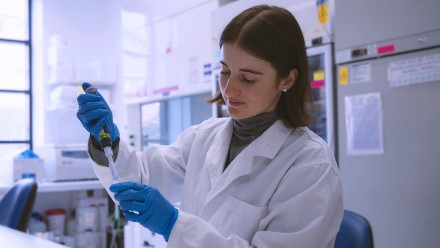Production, properties, patient administration
The starting material is 99mTc as standard Sodium Pertechnetate for injection.
The Technegas generator is essentially a miniature high temperature furnace in which the heating element is also the source of graphite vapour which ultimately coats the Technetium metal. The heating element is made from 100% pure spectroscopic graphite whose electrical and mechanical specifications match the requirements of the machine. It is a 6mm square section rod 50mm long, machined to form a crucible in the centre section such that it can hold a liquid volume of 0.14mL. This hollowed and thinned section also provides the high resistive portion of the rod which becomes the hottest section when electric current is passed through it. The rod is held under spring tension between two high current electrodes. In the present commercial machine, the entire assembly is mounted as a drawer section sliding into the lower chamber of a 6L vessel, and electrically powered from an automatic process
controller.
The crucible is first filled with liquid Sodium Pertechnetate in normal physiological saline, which in most instances contains enough activity [ 260-370MBq or 7-10mCi ] for a single patient administration. The drawer section is then closed and the automatic process takes over, gently blowing pure argon gas over the top of the crucible while warming it to 70°C. This is known as the "simmer" cycle, and takes 6 minutes, during which time the liquid in the crucible dries out and the whole chamber is purged with pure argon, replacing all the original air and water vapour.
At this time the patient is usually prepared and rehearsed with the single use plastic breathing set containing a special filter to capture exhaled Technegas, and is positioned for a posterior view on a gamma camera preferably in the supine position.
The process controller alerts the user that the machine is ready to produce Technegas. At this time, if the initial load of activity is deemed to be inadequate, the process may be 'cancelled' the drawer opened and another 0.14mL of solution added to the crucible. The simmer process is then repeated. This stage of the operation may be performed as often as necessary. The use of an external 'oven' is often employed in busy departments with less than optimum concentration of Pertechnetate solution to simplify and speed up the process, but at least one 6 minute simmer time is necessary to produce the 100% argon atmosphere necessary to generate pure Technegas.
Traces of oxygen as low as 0.1% will produce at least some Pertechnegas, the level rising rapidly to near 100% above 0.5% oxygen.
At the conclusion of this preparation phase, the machine is activated via the control panel 'start' button, and the crucible temperature rises to 2550°C by resistively heating it with about 4.5kW of power within 0.75s and holds that value ±50°C for 15s through a feedback servo from an optical sensor before switching off. This fills the 6L chamber with Technegas ready for immediate use via inhalation by the patient.
For operational convenience, the machine allows a 10 minute window in which the Technegas may be administered to the patient, and this is generally accomplished in 2-3 breaths, depending on many variables related mainly to the technique of administration.
Properties of Technegas
Careful observations in our lab by the late Rod Browitt, revealed an intriguing mechanism for the creation of Technegas. It was always somewhat counter-intuitive that Technetium metal should suddenly volatilise a little way above its melting temperature (2157°C) when its boiling point is 4165°C. Also, although graphite has a steep partial pressure profile with temperature in the 2-3000°K range, some 6 orders of magnitude, predominantly releasing Carbon as C-C-C triplets, (“Thermodynamic properties of carbon up to the critical point”. Leider HR, Krikorian OH, young DA. Carbon 11: 555-563; 1973.) it still did not explain the sudden “lifting off” and Technegas production. It is now hypothesized that the sudden lift-off is caused by the striking of an AC arc from the intense thermionic plasma inside the crucible, and that it is this arc that ablates the technetium and graphite simultaneously. Evidence for the validity of this theory comes from the interesting fact that if the crucible is heated by direct current, Technegas production is greatly impaired and is not sudden. It would seem the peaks of the 12V AC sine wave are necessary to trigger the arc and hence produce rapid and efficient Technegas production. Ignition of this arc may also explain the abundance of pure Fullerenes observed in the vapour. Mass spectrometry reveals a large spectrum of Fullerenes, but no mass shift to suggest they carry Tc atoms.
Co-condensation in the gas phase
An experiment was conducted in which Technegas from about 2GBq of 99mTc- Pertechnetate in the crucible was produced with the generator unit against the collimator of a gamma camera set to run in cine mode. The sequence very clearly shows the sudden lift off and “spout” of activity rising rapidly for about 10cm. It then appears to pause momentarily before dispersing convectively in the chamber. We believe this pause point represents the condensation of the Tc vapour to the solid crystalline state and the assembly of the Carbon triplets into 6 member rings and then graphitic sheets to coat it.
Although the aerodynamic characteristics of the particles are not known, it is clear from their dimensions that they will suspend in air indefinitely under stable thermal conditions, supported by the kinetic energy of the surrounding air molecules, and diffusing rapidly in all directions from their point of insertion into the atmosphere.
From experiments with the ground-state 99Tc nuclide, so far unpublished, it is clear that the particles are inert in the rat for periods of up to three months, whether inhaled or injected. No experiments beyond that point have been performed to date. But there is no reason to suggest that the graphite coat will not remain intact indefinitely once formed. Some early work in vitro showed the cocoon of graphite was stable to several hundred degrees around the Tc metal crystal.

The particles are clearly hydrophobic, which is of considerable importance in a lung agent as they will repel from aqueous surfaces and water vapour, only being trapped by the surfactant material present in abundance in the alveolar (respiring airways) region. Imaging of lungs of volunteers up to 22 hours following Technegas inhalation has shown a less than 3% loss of activity from the lung field in that time. The combination of this observation and that a 5 second breathold on end inspiration during the breathing manoeuvre raises the per breath retention from 20% to 80%, demonstrate unequivocally that virtually all the activity reaches beyond the 16th division of the bronchial tree ( the foot of the muco-ciliary escalator ) to the respiring airways.
They are not strictly metallo-fullerenes because there is more than one layer of graphitic coating and there is no evidence of five member rings in the structure. This animation depicts a conceptual view of the Technegas particle. The 5 to 30 nm central crystal of technetium metal is covered by a thin, but multi-layered graphitic shell.
Clinical Technique
The biggest variable in the administration of Technegas is the patient.
The generator, through its automated control circuits, makes extremely reproducible amounts of Technegas. The level of anxiety created by the need to use a nose clip, or the mere presence of all the Nuclear Medicine apparatus, can create hyperventilation and breathing difficulties generally, which could compromise the efficacy of the test. In addition, if the patient has acute chest pain or dyspnoea, the ability to perform the optimum deep breathing manoeuvre and breath-hold could be minimal. This does not of itself present a major problem, if the patient's respiratory condition is assessed before hand, since more activity may be added to the crucible to whatever level is desired (see below ).Thus rehearsal with the breathing system independent of the generator is of crucial importance in allaying the patient's concern. In training your patient, get them to imagine they are drinking via a straw. This enhances a true sucking action from the mouth.
The nose clip has been identified as the most critical item in maintaining a good seal. Despite the temporary discomfort to the patient, take particular care to ensure that the clip is placed low enough on the nostrils to effect complete occlusion. Patients with large flared nostrils pose a real challenge in this regard, and a proper respiratory facemask may be preferable in these persons.
Patient Posture
If at all possible, patients should be supine or as nearly so as they will permit, for both the inhalation and the injection phase of the V/Q procedure,and of course the imaging phase. There are practical physiological reasons for this.
The patient will lie still, and become far more relaxed for imaging. This will minimise organ movement and make the image quality far better for interpretation, in particular, the degree of congruency between ventilation and perfusion will be optimum. Breathing is usually diaphragmatic when supine, leading to a better registration of the lung fields on the camera during breathing, and hence judging the amount of Technegas to be inhaled. The V/Q gradient in the lung will be matched. The difference in effects of posture on the ventilation distribution for Technegas is easily measureable, underlining its gas-like property.
Best administration technique
It has become evident that the newer multi-head cameras pose some problems for breathing up the patient under the machine itself. The main one is that even the slightest leakage of Technegas during the procedure usually from the patients lip seal or nose can lead to its intake into the cooling fans of the camera head, or even on the collimator face, delivering a rather bizarre background pattern and increased count. Another issue is that some cameras do not allow much room for manipulating the PAS system and controlling the patients breathing.
An elegant solution originally devised by Mr Mark Butterworth of the Prince Charles Hospital in Brisbane, Australia and now practised in many other centres, is to lie the patient recumbent on a bed in the ‘hot’ laboratory or some other side room. Then take the standard radiation protection monitor as used for routine contamination surveys and sheath it in a plastic bag, and have the patient hold it against the right anterior mid lung zone of his or her chest. Breathe up the patient with Technegas in the usual way (see below) until the activity registered on the monitor reaches a pre-determined value ( usually marked with an indelible line on the meter cover). This pre-determined value has been obtained by measuring the value obtained from a known injected dose of MAA over a series of patients as part of their normal investigation. If desired, a table relating male/female and body mass index (BMI) to a monitor reading can give more individual correlation to the activity of Technegas inhaled.
Once the inhalation manoeuvre has been completed, the patient can be returned to the waiting area until the camera is free for their imaging procedure.
Busy departments report on the practical effectiveness of this procedure and have up to five lung studies waiting at a time. The postural difference compared with lying supine for the MAA injection is a gravity gradient not related to lung segmental anatomy per se, and no confusion with interpretation for PE mismatch is reported.
The inhalation manoeuvre
If the patient is at all dyspnoeic, or has known hypoxia, it is advisable to insert a short length large bore (eg 17g.) needle, connected to the hospital oxygen line, into the PAS delivery tube and deliver a steady flow of oxygen at 6-10L/min. Alternatively, the patient may be given a few breaths of pure oxygen immediately before inhaling Technegas.
The latter method has the advantage that it does not dilute the incoming Technegas and keeps the breathing time to a minimum, but the former method is useful particularly with the frail-aged who tend to defeat the mouth seal. In these, any leakage of Technegas, being dilute, poses less of a contamination issue near the gamma camera.
Ideally, the patient should inhale as slowly as possible to minimise turbulence in any obstructions in the bronchi, from Functional Residual Capacity, to a reasonably full but comfortable inhalation maximum. Inhalation to vital capacity is not recommended any longer since it has been found that modern cameras and SPECT imaging can detect the excessive Technegas concentration apparent when the patient is breathing quiescently for imaging. This shows as an increased signal long the posterior, dependent, boundary of the lung, where the gravitational compression is seen. This has been spectacularly demonstrated in a recent paper where subjects were administered Technegas within a centrifuge at 3G (biblio #296). Then when the perfusion injection is performed it is preferable to have the patient breath-hold at about the same level to ensure the most even V/Q distribution.
The breath should then be held for 3 seconds at least but no more than 5. This is a vital part of the procedure as it allows the convective flow to cease long enough for pure diffusion to cause the particles to migrate to the surfactant medium in the alveoli, where they stick (see Properties of Technegas for further details). As an example of the value of this part of the procedure, measurements have been done to show that breath-hold to no breath-hold can cause inhalation retention per breath to move from 80% to 20%.
The whole manoeuvre is repeated until the count rate on the gamma camera reaches the level predetermined by the department protocol. This is usually about 2,500 counts/s, the value corresponding to about 37MBq or 1mCi activity inhaled.











